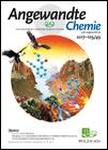版权所有:内蒙古大学图书馆 技术提供:维普资讯• 智图
内蒙古自治区呼和浩特市赛罕区大学西街235号 邮编: 010021

作者机构:BMI Center for Biomass Materials and Nanointerfaces College of Biomass Science and Engineering Sichuan University Chengdu Sichuan 610065 China Department of Chemical and Environmental Engineering RMIT University Melbourne Victoria 3000 Australia School of Biomedical Sciences Faculty of Medicine The Chinese University of Hong Kong Center for Neuromusculoskeletal Restorative Medicine Hong Kong Science Park Shatin New Territories Hong Kong SAR China Department of Chemical and Biological Engineering The University of British Columbia Vancouver BC V6T 1Z4 Canada
出 版 物:《Angewandte Chemie》
年 卷 期:2024年第136卷第12期
学科分类:081704[工学-应用化学] 08[工学] 0817[工学-化学工程与技术]
主 题:Cell surface engineering nanocoating metal-phenolic nanocloak cancer immunotherapy
摘 要:Due to the presence of natural neoantigens, autologous tumor cells hold great promise as personalized therapeutic vaccines. Yet autologous tumor cell vaccines require multi-step production that frequently leads to the loss of immunoreactive antigens, causing insufficient immune activation and significantly hampering their clinical applications. Herein, we introduce a novel whole-cell cancer vaccine by cloaking cancer cells with lipopolysaccharide-decorated manganese(II)-phenolic networks (MnTA nanocloaks) to evoke tumor-specific immune response for highly efficacious synergistic cancer immunotherapy. The natural polyphenols coordinate with Mn 2+ and immediately adhere to the surface of individual cancer cells, thereby forming a nanocloak and encapsulating tumor neoantigens. Subsequent decoration with lipopolysaccharide induces internalization by dendritic cells, where Mn 2+ ions are released in the cytosol, further facilitating the activation of the stimulator of the interferon genes (STING) pathway. Highly effective tumor suppression was observed by combining the nanocloaked cancer cell treatment with anti-programmed cell death ligand 1 (anti-PD-L1) antibodies-mediated immune checkpoint blockade therapy. Our work demonstrates a universal yet simple strategy to engineer a cell-based nanobiohybrid system for enhanced cancer immunotherapy.